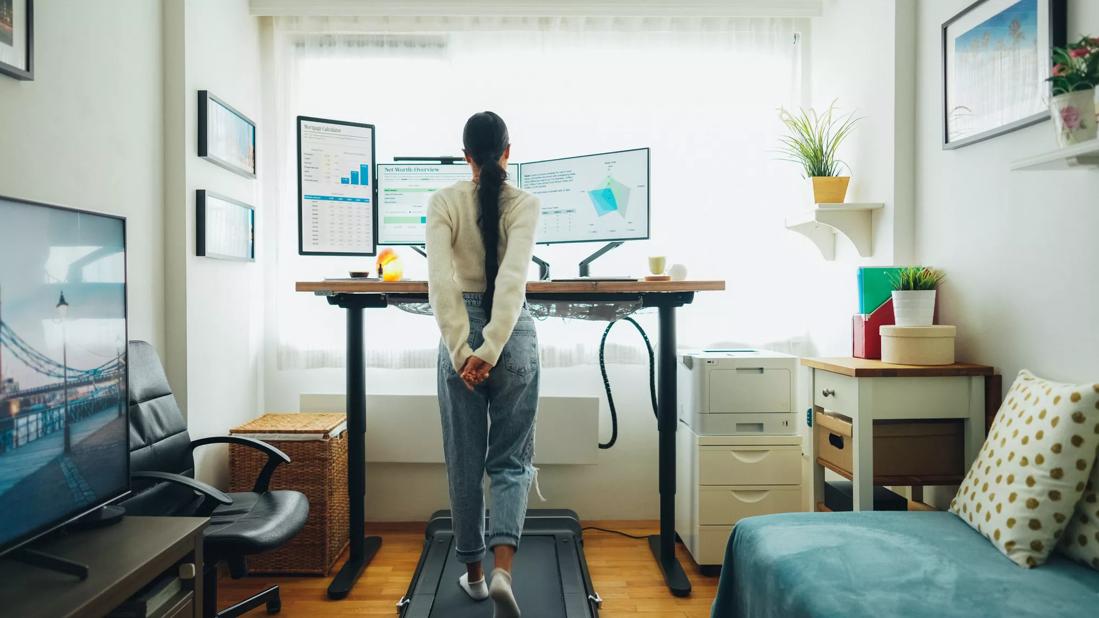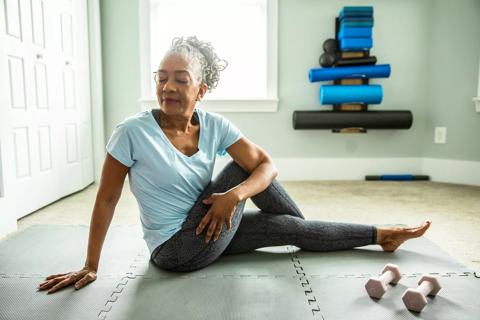Advertisement
A walking pad is a simplified treadmill that can fit under your desk and help you get more movement in your day

Sitting for long periods is one of the worst things we can do for our health. It can hurt your posture. Lead to a smorgasbord of aches and pains. (Hello, dead butt syndrome!) And even raise your risk for cancer.
Advertisement
Cleveland Clinic is a non-profit academic medical center. Advertising on our site helps support our mission. We do not endorse non-Cleveland Clinic products or services. Policy
But if you work at a desk, what can you really do about it? You need your butt in your chair if you’re going to get stuff done.
Or do you?
As more people become conscious of the dangers of sitting too long, a host of products have flooded the market to help you get more movement into your daily grind — even when you have emails to send and calls to make.
Walking pads are among the hottest-selling products to help you get a move on. But what is a walking pad? And will it really do you any good?
We talked with exercise physiologist Chris Dempers, ACSM EP-C, about walking pads. Are they the secret to keeping you moving even when you’re working?
A walking pad is a treadmill belt on rollers that you can fit under your desk. You can think of it as a stripped-down treadmill — fewer bells and whistles and a lower price point.
“A walking pad is like a miniature treadmill,” Dempers explains. “It takes away the fancy features that you see on treadmills at commercial gyms and downsizes it into a 30-to-50-pound device that you can move around freely. It’s a neat little piece of equipment.”
Walking pads can be easily toted around. So, you can pull it out when it’s walking time and stow it away when you need to do some seated work.
Advertisement
Walking pads are essentially the base part of a treadmill.
But unlike treadmills, they don’t have rails (that can double as clothes hangers). Most don’t have adjustable inclines to increase the intensity. And they don’t have interactive electronic displays to monitor your heart rate or watch TV. Just the bare bones.
Most walking pads allow you to speed up some, but they won’t get you moving as fast as a treadmill. For example, a high-end treadmill might reach speeds of 15 miles per hour (a pretty quick run). Walking pads tend to max out around 5 mph (think speed walking pace).
But most people aren’t likely to be able to keep up with banging away on their keyboard while running a 10-minute mile, anyway. The idea of a walking pad is that you can reap the rewards of walking while talking on a conference call — without gasping for breath.
“It’s like the equivalent of walking at a normal speed while texting on your phone,” Dempers says. “When you’re using a walking pad at your desk, you can still type and talk, but it gets you out of your chair. They can help get you up and moving while you’re going about your workday.”
A walking pad can make your work life more conducive to physical movement. Decking out your office (or home office) with a walking pad can give you a chance to get some extra movement in your life.
But does it really “count”? Does clocking in at a breezy walking pace really do anything for you?
The answer: A resounding yes, Dempers reports. “Anything is better than sitting still. Even at a slower pace, you’re still burning calories. If you’re walking 30 minutes, you can expect to burn about 100 to 260 calories, depending on your body weight.”
And you’re still getting your work done and keeping the boss off your back. (How’s that for multitasking?)
Now, is strolling along on a walking pad going to make you drop 10 pounds in a week or get you in top shape for your next marathon? No.
But is it better than slouching in your desk chair for hours on end? Absolutely.
“We say that sitting is the new cigarette. Sit still and you’ll die faster,” Dempers warns. “Long periods of sitting contribute to poor circulation, obesity, heart disease, stroke, diabetes and more. So, I’m a fan of doing anything you can to get some movement into your day.”
Dempers adds that walking pads are usually well tolerated by most able-bodied people who have good balance and don’t use assistive walking devices, like ankle braces or canes.
If you’re going to use a walking pad, start by walking for short periods at a slow pace. Work your way up to longer intervals and faster speeds.
A walking pad is a useful tool for a lot of desk-bound people. But you have to be able to use it if you’re going to reap the rewards.
Let’s take a look at who would benefit most from adding a walking pad to their work life.
Advertisement
If you already live a pretty active life, a walking pad may not add much to the equation. Especially if your work life allows you to take walks throughout the day or hit the gym regularly.
“Walking pads are probably more beneficial to beginning exercisers than for people who are more active and more regimented with their workouts,” Dempers says. “If you already get a lot of exercise, a walking pad might not add too much. But if you’re going from a more sedentary life to starting to use a walking pad, you might find more benefit.”
A walking pad is going to be less expensive than an all-out treadmill, but there are some financial questions to consider.
First, walking pads typically range between $100 and $200. Fancier versions can set you back closer to $400. And to make it work, you’ll need a standing desk, likely one that adjusts to also be useful for seated work between walking sessions. That might cost another $100 or more.
And don’t forget the walking shoes! Most office-appropriate footwear probably isn’t going to be a supportive choice for walking.
And if you’re working from the home office, Dempers suggests that walking barefoot isn’t the best move for a beginner. “More and more people are getting into barefoot exercising. But if you aren’t accustomed to walking long distances barefoot, you can run into overuse injuries.”
There’s also the question of whether a walking pad works for your work.
You may find that using a walking pad during a video call with clients, for example, could be a distraction. Or your office attire may not be up to the task of long periods of walking.
If you often work independently, have a private office or work from home, putting in some walking-pad time may be easier to work into your day.
Walking pads can help get in some extra movement throughout the day for people who sit a lot. It’s not going to radically overhaul your health, but it is a step (or maybe a couple thousand steps) in the right direction.
“A walking pad can be a useful tool to add to your exercise regimen,” Dempers advocates. “If you’re looking to burn some extra calories and you have an opportunity to do it during your workday, why not?”
Advertisement
Learn more about our editorial process.
Advertisement

Exercising can actually improve arthritis symptoms — and low-impact exercises are best

Bulgarian split squats, hack squats and goblet squats are just a few of the moves you can try

While walking, be mindful of your body, your mind, your place in the world and all five of your senses as you pave a path forward, one step at a time

Squat smart with proper technique, including a neutral spine, wide knees and an engaged core

This important step gives your body time to return to its resting state while reducing muscle cramps, dizziness and injury

The short answer? The best exercise is the one you’ll actually do

Walking is a great goal, but how many steps are best for you depends on factors like your fitness level and age

First, reflect on your specific workout goals, and then pick and choose your fitness equipment

Focus on your body’s metabolic set point by eating healthy foods, making exercise a part of your routine and reducing stress

PFAS chemicals may make life easier — but they aren’t always so easy on the human body

While there’s little risk in trying this hair care treatment, there isn’t much science to back up the claims